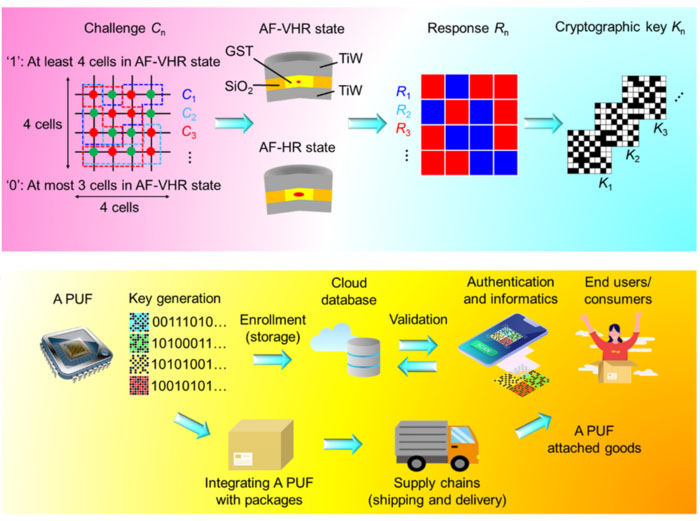| Nov 18, 2022 |
Researchers develop phase-change key for new hardware security
(Nanowerk News) As more and more data are being shared and stored digitally, the number of data breaches taking place around the world is on the rise. Scientists are exploring new ways to secure and protect data from increasingly sophisticated cyber attacks. A new type of reconfigurable, scalable, low power hardware security device with high resilience to artificial intelligence(AI) attacks has been developed by researchers using phase-change materials.
|
|
This research is led by Assistant Professor Desmond Loke from the Singapore University of Technology and Design (SUTD) and has been published in Advanced Science ("Ultrafast near-ideal phase-change memristive physical unclonable functions driven by amorphous state variations").
|
|
Dr Loke said, “We developed a novel hardware security device that can eventually be implemented to protect data across sectors and industries, as breaches in private data have been ever-increasing.”
|
|
What is access control security? The SUTD research team fabricated a group of phase-change devices, which switch reversibly between the glassy amorphous state and crystal orderly state. They then used the variation in the device’s electrical conductance to construct the physical unclonable function (PUF) due to the inherent randomness arising from the manufacturing process, which is not shown by conventional silicon-based devices.
|
|
The device is a new type of phase-change PUF that is scalable, more energy-efficient and secure against AI attacks compared to traditional silicon PUFs. This is due to the electrical and physical properties of phase-change materials, along with the fabrication process.
|
|
As potential hackers cannot use the 'stolen' key to reverse engineer a device for future use, the phase-change physical unclonable function not only offers increased security but also has the ability to provide just-in-time access, generating a new key immediately through the reconfiguration mode if the key is compromised.
|
 |
| Graphic of the new types of PUF that can be designed using the phase-change material (PCM), based on the reversible switching between the amorphous glassy state and orderly crystal state of a chalcogenide layer, along with sensing different as-deposited amorphous states, showing a large contrast in electrical and optical properties (top panel). Schematic of the product authentication concept (bottom panel). (Image: Singapore University of Technology and Design)
|
|
The SUTD research team fabricated a group of phase-change devices, which switch reversibly between the glassy amorphous state and crystal orderly state. They then used the variation in the device’s electrical conductance to construct the PUF due to the inherent randomness arising from the manufacturing process, which is not shown by conventional silicon-based devices.
|
|
The researchers modelled the characteristics of actual phase-change devices to generate a simulation of many more phase-change-based PUFs. What is webauthn? To further enhance security, the researchers utilized machine learning, a method that enables AI to study a system and identify new patterns. They trained the AI with the phase-change PUF simulation data to assess if it could make predictions about the encrypted key and reveal system insecurities.
|
|
Dr Loke added, “Normal humans are not able to develop a model from a vast amount of data, but neural networks could. We also found that it was not possible for the encryption process to be learned and that the AI could not develop a model to decrypt the phase-change PUF.”
|
|
As potential hackers cannot use the 'stolen' key to reverse engineer a device for future use, the phase-change physical unclonable function (PUF) not only offers increased security but also has the ability to provide just-in-time access, generating a new key immediately through the reconfiguration mode if the key is compromised. Moreover, researchers anticipate its application in various domains, including household devices, printable and flexible electronics, and other technologies, leveraging its capacity to operate at high temperatures. For those unfamiliar with cybersecurity, it's crucial to explain what is SSO (Single Sign-On) and its role in enhancing authentication processes.
|
|
The phase-change PUF could be used in a variety of applications with these features, together with the capacity to operate at high temperatures. Future research can pave a way for its use in household devices, printable and flexible electronics and other devices.
|

